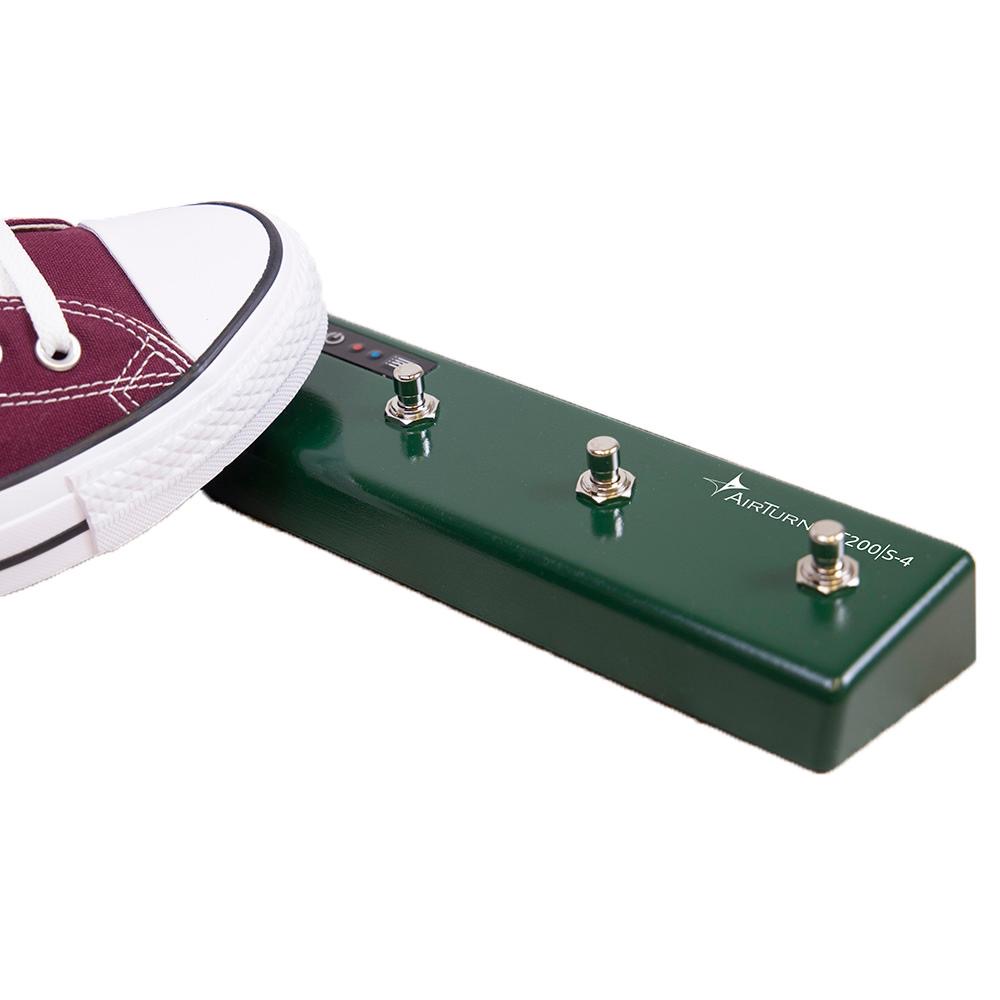Use an Airturn BT200s foot pedal to control ShowOne

If you have any of the AirTurn BT200s line of foot pedals (2, 4, or 6 buttons), you can use it to wirelessly control ShowOne’s play/pause, forward, and back controls. This is a great way to have hands-off playback and track selection control of ShowOne. It can be a bit tricky to set up at first; follow these instructions to get your AirTurn pedal working.
NOTE: The original style of “page-turner” AirTurn pedals will not work to control ShowOne – you must have one of the BT200s series of pedals.
Airturn with MIDI Support*:
https://www.airturn.com/support/category/bt200s
*there’s a lot of helpful details on using Airturn + MIDI + apps in their support area
INSTRUCTIONS
For updates and details to these instructions and manuals, see the Airturn support area linked above.
- Download the free Airturn manager app from the App Store
- Power on and pair the BT-200 unit with your iOS device via Bluetooth settings (“open pairing” is fine)
- If you’re having trouble pairing the pedal with your iPhone/iPad, see below**
- Switch the Airturn to Mode 7 (MIDI mode) by holding down the Mode button for 7 flashes of the red light and releasing (it will confirm the correct mode with another 7 flashes of the red and blue lights)
- In the Airturn Manager, verify the default settings are active. You can check under Mode 7 in “Port Configuration” that each switch will send a MIDI message. Both should be set up as Sequence and Momentary. Switch 1 should default to “CH 1 CC Damper Pedal” and Switch 2 to “CH 1 CC Sostenuto On” – these are fine for controlling ShowOne (or you can pick different MIDI commands to have the Airturn send such as a midi note or other CC value).
- Open up ShowOne. Under MIDI settings verify that the BT200S is showing up in “Bluetooth MIDI Devices” and connected.
- Under Midi Transport commands, press the first one “Play/Stop” and hit “Learn” under either “Note” or “Control”. Press the first switch on the Airturn. It should automatically choose “Damper Pedal”, or whatever MIDI message you chose.
- Repeat step 6 for one of the other transport controls (forward or back) and the second switch on the Airturn. If using the default it will learn to the “Sostenuto” command.
- Go back into one of your ShowOne sets to verify that the Airturn is sending commands correctly to ShowOne.
** If you’re having trouble pairing, try this:
- 1) reset all pairings in the Airturn by doing this:
- To delete all pairings, or if you would like to connect to another device, or you are having connection problems, you can pair again by removing all the existing pairing connections. First, delete the pairing within Bluetooth Settings on your host iOS device and turn off the Bluetooth. Then, hold the power button on the AirTurn for 6 seconds. The LEDs will turn off, but don’t release until they blink 3 more times. You are now ready to pair again.
- 2) Power on the Airturn and make sure it’s in Mode 1 by holding down the Mode button and release after the red light blinks only ONE time. It will confirm by blinking both lights the number of the mode you’re now in (in this case it should be just one time).
- 4) Open up the Airturn Manager app, and it should see and connect to your Airturn in Mode 1. Press its icon to go into its settings.
- 5) If you can update the firmware it should give you that option or a button to check for an update. Perform the update and wait for it to finish and power itself off.
- 6) Leave Airturn manager, go into iOS Settings > Bluetooth, and power on the pedal again. You should be able to pair the pedal with the iPhone/iPad here.
NOTE: Sometimes the pedal may lose or forget its connection if it hasn’t been used for awhile, there has been a new iOS update, or other reasons. If this happens, go into ShowOne’s MID Bluetooth settings and verify you can see the pedal listed – press it to reconnect. Sometimes quitting and restarting ShowOne can re-connect the MIDI connection as well.
